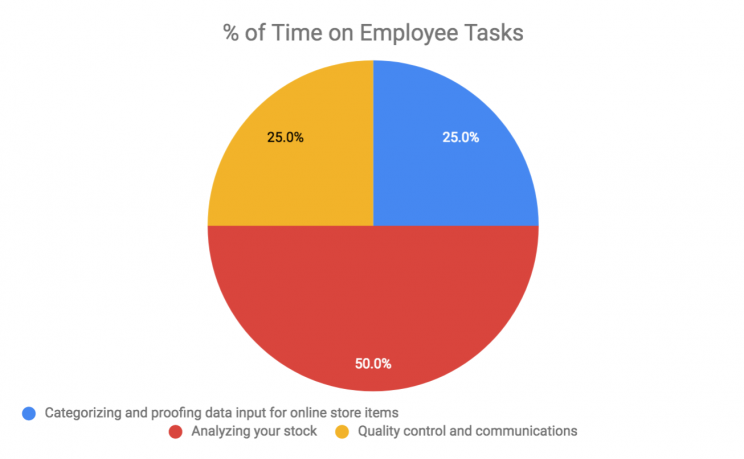Image technologies — notably deep tagging and AI — are propping up all over the consumer space, from ASOS to Pinterest to Boohoo. What they can do for consumers is obvious to anyone who has encountered the tech. They make shopping easier and faster and can help consumers make decisions about purchasing with features like digital try-on.

If you’re an ecommerce retailer, the better consumer experience can be reason enough to adopt image technologies on your website or app.
But that’s not all that today’s image tech can do. Yes, there’s a huge benefit on the consumer side, but ecommerce companies can also use image technology to significantly improve their internal processes as well.
Simply put, they take a lot of hassle out of the way retailers treat inventory and how they can push new features to appeal to consumers. And, if you are outsourcing the technology to a SaaS company that’s already developed that capacity, you can do it without huge startup times — as fast as a 24-hour implementation.
Bringing automation up to standard
There has been a growing push towards automation in a range of industries, from finance automation to ecommerce product tracking. One place that hasn’t had a huge turn towards automation has been ecommerce product inventory.
The traditional way to create an inventory CSV is to have teams of people manually inspecting and categorizing items. For simplicity, say you employ five people for this work and pay them each $1,000/week, or $4,000/mo. These employees spend their time as follows:

A quarter of these employees’ work is going towards manual categorization, which means your average spend on this category is $1,000/mo per employee, or $5,000/mo.
Now, you introduce image technology into the mix. With photo recognition tech, you can have one employee take a photo of each item and run it through your software to automatically create a CSV for your products that contains tags for everything from style details (dropped waist) to fabric qualities (leather, shiny).
This means that 25% of four employees’ time is freed up for other tasks. That’s $1,000/mo per employee, or $4,000 a month. If you reduce hours, that’s $4,000 in savings. If you reassign that time to quality control and communication, that’s $4,000 that can go to better service and a higher functioning team.
Aside from the elimination of that rote work for your employees, you’re also putting in place a more accurate system. Human errors in tagging, like spelling or inconsistent use of terms, is reduced with this automation.
This is automation that creates a tangible difference for your bottom line and the quality of your product offerings, even though your consumers may never know about it.
Improving search features, not just adding new ones
Search for items in a digital inventory is messy and can be difficult in ecommerce, where consumers know what they want but have to describe it to machines. Image recognition tech can give an ecommerce company better search features in more ways than one.
Of course, there’s visual search, which can be a huge benefit to consumers trying to find specific pieces, from clothing to sofas.
But there are also the ways in which image technology can improve your regular search as well. With deep tagging features, image technology can help categorize your items better within a normal text search. So when users want a one-shouldered shirt, that’s what they get, and if they want a blond-wood table, that’s what they see when they search.

Take this search for “pink short dress” on John Lewis:

And compare it with this search with the same terms on Boohoo, which use Syte’s image tech:

As a customer, having those terms actually correspond to results is important. Half of the returned search results on John Lewis’s site can’t be classified as short at all.
Because of the superior breakdown of items, retailers can implement better ways to filter searches as well, in the same way that search results are improved. And all of this comes as an update to the existing search system, upgrading the features your users already know and use.
Tackling the ecommerce personalization beast
Consumers in 2018 want a personalized experience, and ecommerce businesses need to keep up with their desires.
Personalization in ecommerce retail is hard because you don’t get the same deep dive into users’ habits as on other digital platforms. On Spotify, users play their favorite songs dozens of times, save albums, add themselves to playlists, share songs, and use the app for hours a day.
But while shopping, consumers bounce around, buy from multiple places regularly, abandon their carts, click on things they like but will never buy, and only purchase a limited number of items at a time, often at the cadence of once a month or a season — for large purchases even less.
So how can ecommerce companies gently personalize their shopping experience in a way that doesn’t rely on a huge number of data points or on trying to source consumer data from third parties?
If you guessed image technology, you guessed right. Image tech can help you implement personalization even without having a history with a customer:
- They can personalize “get the look” features by immediately seeing alternative options.
- They can find items curated just to their taste with a “similar suggestions” feature when they click on or hover over a piece they like.
- Digital lookbooks can be shoppable, getting customers into outfits and aesthetics they like without having to search in different departments.

While these are consumer-focused applications, it is easy to see how they represent a benefit on the back end for retailers. An ecommerce company does not have to undertake an extensive campaign to pull together data to try and squeeze out info for deep personalization — users can do it themselves with image tech. That’s time and money a company doesn’t have to spend trying to work out an impossible problem.
If you want it, go get it
Last, but certainly not least, this tech is all available today. There is no need to wait to implement these features and reap the benefits of image technology. If you want a demonstration on what this tech can do for you, contact us today.